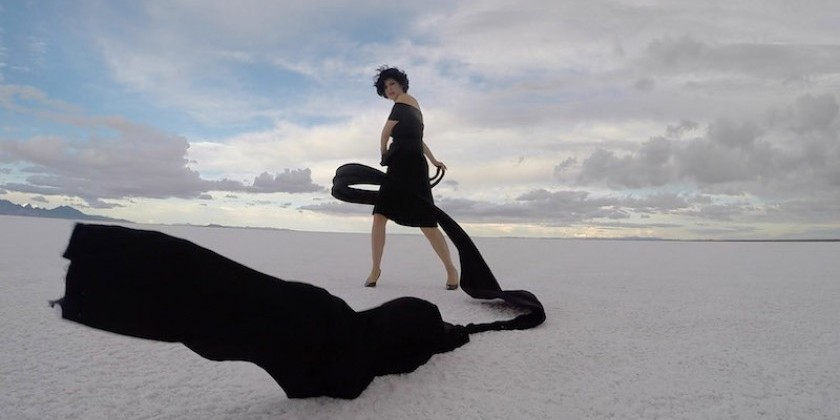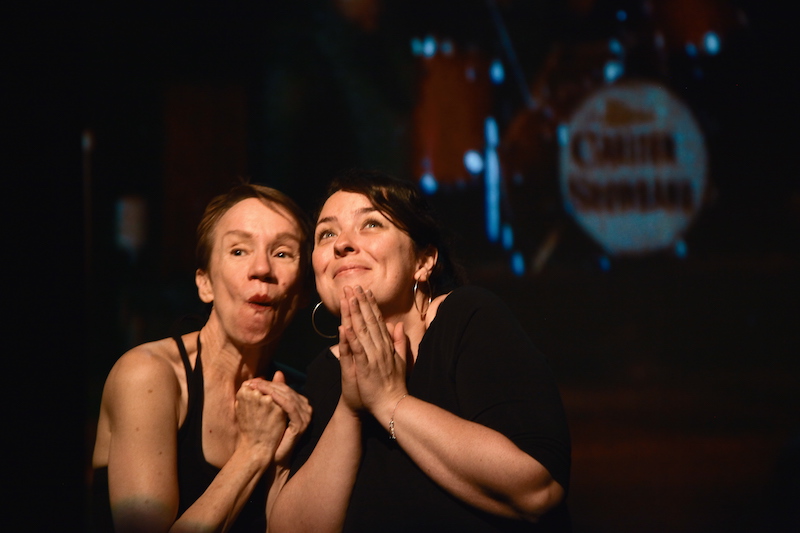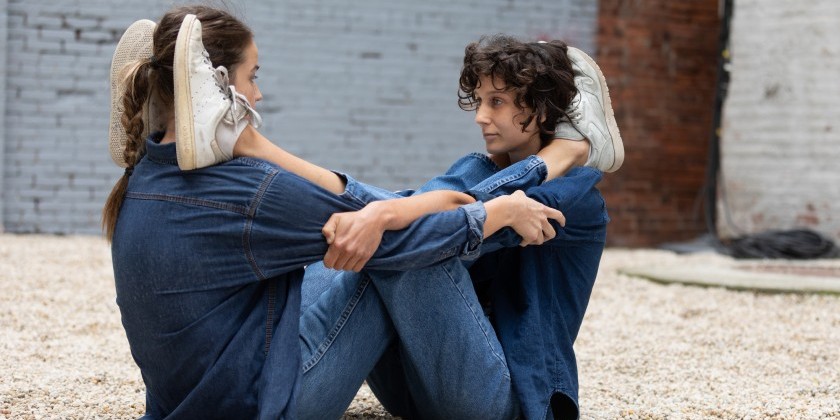Celebrating the Thirtieth Season of the Performance Mix Festival (Part II)

Arthur Avilés, Roxane Butterfly and Jil Guyon
Performance Mix Festival
Abrons Art Center
June 6-11, 2016
Tickets are $20 (or free admission where indicated online) and can be purchased online at www.abronsartscenter.org or by calling 212-352-3101.
For thirty years the Performance Mix Festival has provided a unique platform for experimentation and creative risk-taking by both emerging and established artists. Representing highlights from the past three decades of artists, the eclectic program includes experimental dance, improvisation, performance art, theater, new music, and interdisciplinary works, as well as Performance Mix’s annual community breakfast, artist talks, and surprises. The Dance Enthusiast caught up with a few Performance Mix Festival artists as the season kicks off at Abrons Art Center. For the full festival line-up go to the Performance Mix Festival website.
Arthur Avilés - Former Bill T. Jones/Arnie Zane dancer, choreographer and co-founder of BAAD! (Bronx Academy of Arts and Dance)

Trina Mannino for The Dance Enthusiast: You’re bringing back the work Garden of Mi Amigo El id from the Kamikaze series that you originally performed yourself over ten years ago at the Performance Mix Festival. Can you speak about that initial experience? What was the inspiration behind it?
Arthur Avilés: It was 2003... I was at the height of two crazy experiences: contemplating my existence in my dancing body as I was getting older and the 9/11 mania. I had no idea what I wanted to do, yet I decided to do whatever came to me. I wanted to take my body to the hilt of it's powers…I called this head space Kamikaze... Garden of mi amigo Mr. id is dance expressing the Id; alive and present, ever changing. A sequence of non sequiturs as the body flips trounces and flounces through space.
Here we are 13 years later, and I have asked the extraordinary dancer Jonathan Gonzalez to help me reconstruct this piece from a video. We have made the piece fit his body type [which is different than mine]. I am big boned and 5 feet 4 inches and he is 6 feet 4 inches and slighter than me. There is something I cannot explain that we share...
The piece is not suicidal as the way the word Kamikaze suggests. There is something about the act of leaving the dance that has existed in my body for a long time and executing the last remnants of my powers as I age.
TDE: What was your first introduction to founder Karen Bernard and her Performance Mix Festival?
AA: In 1988, Karen, along with the choreographer, my mentor and dance teacher, Jean Churchill, took me out of the country for my first time. I was 25-years-old and was a kid amazed by the great town of Edinburgh. Throughout the years since then I was lucky enough to have had Karen ask me to join her series periodically.
TDE: What new things have emerged from this revival?
AA: My relationship to Jonathan has become closer in sentiment and respect. My appreciation for the space Karen has given to works that are just not possible to present in so many places is so greatly appreciated.
Multidisciplinary artist Jil Guyon

TDE: You are participating in the festival as both a dancer in Karen’s Damn Your Eyes and in your own work. What’s it like to be directed by Karen in a piece she choreographed originally for herself? How have you found your artistic voice in this iteration?
Jil Guyon: The performance appears easier to perform that it actually is. There’s a great deal of nuance in each gesture. It's quite intricate and operates on the edge of seduction and defiance. Karen has been both exacting and patient in her direction — giving tips on how to finesse each movement and the motivation behind each section. Her performance quality is so distinctive and uniquely hers, I can’t possibly match it. But it’s an interesting challenge for me to work with a movement vocabulary I wouldn’t otherwise explore, and to bring to the surface contradictory aspects within myself. It’s my hope that my own work will be further refined as a result of this project.
TDE: How did you and Karen first meet? Can you speak a bit about those early experiences?
JG: I first met Karen at a performance feedback workshop. I was impressed by the rigor of her feedback. When I heard she would be leading another group, I eagerly joined… It was during that workshop that I started developing a solo movement-based work entitled Widow. Widow was a character I had created for Noemie Lafrance’s Agora II at the McCarren Park Pool in Brooklyn. About a year after Agora II, I was listening to the soundtrack from the film Bladerunner and the Widow character re-emerged in my imagination in the form of a solo performance. Karen’s workshop was an opportunity to flesh out those ideas, and the first iteration of the Widow was presented at Performance Mix in 2009. A few years later I made the performance into a dance-film of the same title.
TDE: Can you talk about Desert Widow, which is described as “part live solo performance and part photographic cinematography"? Where was it filmed? What was the source of the work’s inspiration?
JG: Desert Widow is the second film in a series based on the Widow performance. I wanted a location that both resembled and juxtaposed the first. I began to imagine the character in a desert. A friend mentioned the Bonneville Salt Flats in Utah. I did a Google search and the images that came up felt right…My cinematographer, Valerie Barnes, and I flew out to Utah for 4 days. And our time there was magical. I felt free in the the landscape. Its vastness allowed me to depart from the original choreography and experiment with distance and pacing. But there was one caveat. On the last day of the shoot the Flats transformed into a lake about 3 inches deep. Heavy rains the night before caused a flood, and my plans for our final day were thwarted. At first I despaired. But Valerie and I decided to go ahead and shoot in the water despite the limitations it presented. What felt like a misfortune turned out to be a “blessing in disguise.” The water became an essential element in the film.
TDE: Did you always see your visual art, film work and dancing converging? What draws you to a multidisciplinary approach?
JG: I see my training as a visual artist as the foundation of all my work. Images well up and ask to be made manifest in a particular form. It's not something I consciously choose. I thought the first widow solo performance presented at the Mix in 2009 would also be the last. I never envisioned it having a future. But it seems to have its own momentum and has continued into the present. For me, to alternate between disciplines allows for an exploration that is more multidimensional in scope. That dynamic also keeps my vision alive and unpredictable.
Underground tap icon Roxane Butterfly

TDE: When was the first time you were involved with the Performance Mix Festival? How did you and Karen first meet?
Roxane Butterfly: The first time I collaborated with her was at the Kids Café Festival in 1999 when she invited me to present my whole women group, BeauteeZ and The Beat, at the Tribeca Performing Arts Center… But most importantly, it is my connection to the tap dance comedian, historian and legend Jane Godlberg, who happens to be a dear friend of Karen’s.
I was fortunate to appear in Performance Mix in 2013. I really appreciate the efforts made on bringing such diverse forms of dance together in a privileged environment (small theaters) where the connection with the other artists and the audience is so intimate. I think we need more of that.
TDE: This year, you’re curating the improvisation evening “Raise the Hoof.” What prompted you to bring this diverse group of hoofers together?
RB: I simply love directing collective improvisation. I love being challenged and to keep on learning. I love my elders, my contemporaries, my successors. Continuity is key to the survival of our art. Max Pollak has been one of my best ''partner in (tap) crimes'' for the last twenty-five years…He always made me secure about my choices of trying new things and my attempts to modify the mainstream perception of presenting tap, especially being a woman. It is always a deep feeling to dance with him as we both reconnect with our multiple selves when we jam. Our dancing is full of memories, joyful ones, and painful ones too. I think it is important for an audience to witness the kind of strength that sharing a life in dance can bring into our existence. As for our elder Jane Goldberg, she is the ''ultimate tap witness.'' It's always a sensation of sacredness to be around her…In a similar spirit of sharing and community building, while being a ferocious rhythmic-ian, comes youngster Hillary-Marie Michael, founder of the well celebrated New Jersey Tap Festival. To embrace the various voices of all of us, I could not think of a better fit than Jennifer Vincent, one of New York's most versatile bassists, who has played for numerous of my projects over the years.
TDE: You’re also dancing in “Spontaneous Connections: Improvised Music” with multi-instrumentalist and vocalist David Garland, vocalist and percussionist Anaïs Maviel. Have you worked together before? What makes a successful improvisation collaboration?
RB: Guess what? We do not know each other yet. And so we will keep it real. It will be improvisation and spontaneous! A successful improvisation/collaboration means: Listening to one another, letting space for the other to react, proposing few ideas at a time, be willing to be fragile and not get the answer you may expect, not care about ''doing right'', and taking the time to march towards the other.
2016 Performance Mix Festival Performers


















































